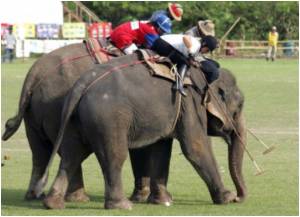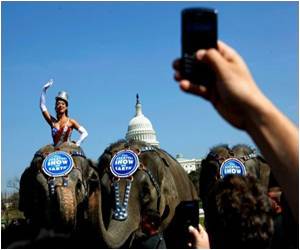
First, the head honcho moves away from the group, turns her back and gives a long, slightly modulated and - to human ears - soft rumble while steadily flapping her ears. This spurs a series of back and forth vocalizations, or rumbles, within the group before the entire family finally departs.
The use of "rumbles" to initiate departure helps explain the group's ability to work together to achieve more complicated tasks, such as rescue operations to save a calf from drowning.
"These vocalizations facilitate the bonds between the elephants to be able to work together. It's the measure of an organized society. It demonstrates how another social animal grouping organizes itself through vocalizations," said lead author Caitlin O'Connell-Rodwell, PhD, a field biologist and instructor in otolaryngology at the Stanford University School of Medicine.
The study also indicates how this behavior uses rumbles in a structured way to transmit signals longer distances both through the air and through ground vibrations that could alert other elephant family groups not to approach the watering hole until they're gone, thus avoiding the mass chaos of too many large, noisy bodies at the same watering hole at the same time.
"I've seen 200 to 300 elephants at the same watering hole at one time before. There's a lot of vocalization and pushing and shoving and screaming and roaring. You can see why they'd want to avoid that," said O'Connell-Rodwell.
Advertisement
In this study, O'Connell-Rodwell focuses on sounds. She first noticed this apparent watering hole "departure" conversation years ago while observing the elephants in the wilds. The study occurred between July 1994 and July 1995. Researchers set up scientific observation sites at five watering holes in the Etosha National Park using instrumentation to provide acoustic measurements of the vocalizations and charting behaviors.
Advertisement
"They have a matriarch," O'Connell-Rodwell said. "Then there's this sort of secretary-of-state character, and then you have the general who brings up the rear."
The families consist of the females and the calves. Males over the ages of 12 to 15 leave the herd and form their own groups.
The study confirmed that elephants use vocalization to coordinate action, and that usually three callers are involved in this very coordinated turn-taking conversation.
"It's not just a chorus. As soon as one call ends, another call starts, then the next, then the next. It's connected like a string. Effectively they take a three-second call and turn it into a nine-second call," O'Connell-Rodwell said.
The study was described in a paper published in the October issue of Bioacoustics.
Source-ANI









